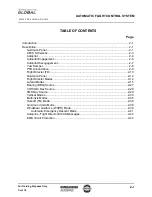
propeller is statically balanced, the blades should be level
1
. If one blade is
heavier than the others (or its centre of mass is further from the centre of the
propeller), it will dip towards the floor. If this occurs, weight can be added to
the hub on the opposite side of the central axis to the dipping blade to bring
the propeller level.
All propellers should be manufactured with blades that have equal mass (and
mass distribution) and so a new propeller should not require static balancing.
Propellers that have suffered damage to the blades (stone chips or tip
abrasion) may well benefit from being statically balanced.
While statically balancing a propeller is worthwhile, the best results will be
obtained if the propeller is dynamically balanced together with the spinner.
7.4. Dynamic propeller balancing
Dynamic propeller balancing involves measuring the actual rotational vibration
generated at a realistic propeller RPM and then adding weights to the propeller
hub or spinner backplate to minimise the measured vibration level. Because
the balancing operation is carried out with the propeller and spinner attached
to the engine, the best possible solution is obtained.
The vibration is measured using a sensor known as an accelerometer. The
accelerometer is securely attached to the engine as close to the propeller as
possible and it measures the acceleration of the front of the engine in one
direction (normal to the propeller shaft). If the propeller is out of balance, as
the centre of mass rotates around the axis of rotation, the resulting centripetal
force tries to pull the propeller (along with the spinner and engine) towards
the centre of mass. This rotating imbalance force acts on the mass of the
engine/propeller combination and accelerates it. It is this acceleration that is
measured by the accelerometer.
+ve
-ve
0
Fig 7.1. Sine wave
If the accelerometer was very selective and
measured only the vibration caused by the
rotating out-of-balance propeller, the signal it
produced for one rotation of the propeller would
look like a sine wave as shown here. In reality,
the measured acceleration waveform is much
more complex than a simple sine wave. This is
mainly because of the vibration generated by the
engine and also the turbulence generated by the
rotating propeller blades. The dynamics of the
engine mountings also affect the waveform.
The balancer's processing unit digitises the
measured acceleration waveform and uses the
1
The propeller will be statically balanced when the mass of each blade multiplied by the distance from the
blade's centre of mass to the centre of the propeller is the same for all the blades.
www.smartavionics.com
44
Dynamic propeller balancing
Summary of Contents for PB-4
Page 6: ...www smartavionics com vi...
Page 12: ...www smartavionics com 6...
Page 20: ...www smartavionics com 14...
Page 34: ...www smartavionics com 28...
Page 40: ...www smartavionics com 34...
Page 56: ...www smartavionics com 50...
Page 62: ...www smartavionics com 56...
Page 68: ...www smartavionics com 62...
Page 70: ...www smartavionics com 64...
Page 74: ...www smartavionics com 68...
Page 78: ...www smartavionics com 72...





































